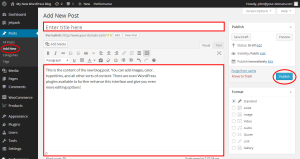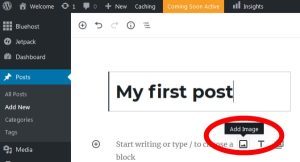In 2023, starting a successful blog is both an exciting and rewarding endeavor. With the ever-growing digital landscape and the continuous thirst for knowledge, blogs have become powerful platforms to share ideas, connect with others, and even generate income. However, diving into the world of blogging can be overwhelming for beginners, especially with the abundance of information and strategies available. To help you navigate through the process, we’ve created a comprehensive guide that will walk you through the essential steps of launching a successful blog this year, ensuring you make a lasting impact in your chosen niche.

Also Read: How to use social media for your business in 2023
Step 1: Choose a blog name
Readers will first notice your blog’s name (such as yourblog.com), so it should ideally reflect the broad subjects you plan to write about.
Alternatively, it may be your name, your company’s name, a creative wordplay, or something else.
The broad subject matter around which you’ll be centering your material is your blog’s niche.
Blog subjects, including travel, gastronomy, fashion, lifestyle, technology, and others, serve as examples.
For the benefit of your future blog visitors, include a word or two in the name of your blog that effectively expresses your Content’s topic (for example, fashionbyjane.com or hikewithryan.com).
If you already have a name in mind for your blog, you may be sure this is the first time anyone else has registered.
You should know the following:
- It should be noted that dashes are the only permitted form of punctuation in domain names.
- There are a few options you have if the name you desire is already taken:
- An alternative domain extension might work. You can still register the.net or.org domain variant if the.com version has already been taken.
- Add a few brief words. Such as “a,” “my,” the best,” or “the.” As an illustration, this website’s name is TheBlogStarter.com rather than BlogStarter.com.
- Put a dash between each word. Scott-chow.com, as an illustration.
A good blog name should be evocative so potential readers may understand your topic by looking at the title.
When choosing a domain name, be sure to incorporate that subject in some way if you plan to blog about it. However, try not to get too focused on a single word.
A cooking blog, for instance, need not contain the term “cooking” specifically. However, people would also realize that your site is about cooking if you used the words “food,” “recipes,” and “meals.”
Use your name, or a close version of it, if your blog is all about you or if you intend to start a personal blog where you cover a range of topics.
If your name appears taken, include your middle name or middle initial. Alternatively, you might use a version like “Blogging with Scott” or “Scott Chow Blog.”
The most popular domain extensions is.com, though.net, and.org also work. It’s also crucial to remember that there cannot be any spaces between words when using a blog domain.
Step 2: Get your blog online
It’s time to launch your blog now that you’ve chosen a name. The steps listed below will guide you through and make the procedure simple, even though it can seem complicated.
Blog hosting, web hosting, and blogging software are required to get your blog up and to run. The good news is that these are frequently sold in sets.
A blog host is a business that stores all of the blog’s files and makes them available to users when they key in the blog’s name. A blog host is necessary to have.
Additionally, it would be best if you had the software to create your blog. The most widely used, adaptable, and user-friendly blogging platform is WordPress.
The WordPress blogging platform is free, with automatic installation, and I will walk you through using it in this post.
Since 2005, WordPress has recommended them for their dependable web hosting, and they currently host over 2 million blogs and websites.
They provide helpful customer care by phone or web chat around the clock.
Step 4: How to Create and Publish a New Blog Post

It’s time to start blogging now that your site is operational! Let’s start by making your very first piece of Content.
- Select “Posts” from the left menu.
- Delete the default post for Hello World.
- Click the “Add New” link to start a new post.
- Publish a new entry on your blog. The screen for the post editor is now active. Write your post’s title in the top box, and then start writing it in the below area.
- To upload a photo from your computer to your post, click the “Add Image” icon and then “Upload.” On the following screen, you can change the picture’s size. When ready, select “Insert into post” to include the image.

- Add a picture to a blog post.
- To publish the new post after finishing it, click the “Publish” button in the top right corner of the screen.
Your blog should offer two basic categories of Content – static and dynamic. The Static Content is specifically created to give visitors the resources they require.
A dynamic blog updates or changes based on the date, category, or even random selection of blog content.
A dynamic blog can increase your website’s engagement with repeat visitors since it encourages them to discover new information each time they go there.
Essential static pages to mention
About Us
A goal statement and a brief biography of the author(s) should be included on this page. Consider the responses to the following queries:
How did your interest in the subject grow? What should be known about you? What do you want to achieve most?
Contact Me (Us)
A contact page lets the visitor contact the author, giving them peace of mind that you are a legitimate and reachable author.
You can include your home address, contact information, and unique email address. Alternatively, use a straightforward contact form to keep your details secret.
Links to your social media accounts should also be included here. In addition to your blog, which is often launched on the home or main page, these two crucial sections should be readily accessible and displayed in your top (header) menu.
Examples of dynamic Content include:
- Personalized product recommendations on an e-commerce site
- Dynamic pricing that adjusts according to demand and supply
- Real-time updates on sports scores or stock prices
- Interactive surveys and quizzes that adapt to user responses
- Live chat features that offer immediate customer support
- Customized email campaigns that alter based on a recipient’s interests or previous behavior.
Read Also: How to create a website in 2023: A beginner’s guide.
Step 5: Promote your blog
Writing excellent Content and designing a beautiful site is just the beginning. It would help if you spent some effort promoting your blog to attract readers, especially when you first start.
The tactics listed below will assist in exposing more readers to your site. You don’t have to employ every tactic; test out a few and determine which is most effective.
Make your inner circle aware
Your close circle should be the very first people to learn about your blog. This includes close relatives, friends, and coworkers in your industry.
Please encourage them to follow you, encourage them to let others know about your new site, and most importantly, express your gratitude.
Promotion on social media
Create profiles on the “biggies” like Facebook, Twitter, YouTube, Pinterest, and Instagram, even though you don’t want to overdo it.
You should include a link to the most recent Content on your accounts. Still, you may also share pertinent news and links to other websites that your viewers find interesting.
Constantly interact with your followers and use hashtags!
Posting links to your blog on your social media accounts, such as Facebook and Twitter, is one of the best for increasing blog traffic.
This is fantastic because not only do your friends see the link, but if they share it with their friends, it automatically increases the number of visits to your website.
Social networking can help your blog go viral if you’ve written high-quality material.
Comment on other blogs
Find other blogs in your neighborhood and comment on them. Introduce yourself and post interesting, helpful comments in the comments section. In addition, you can leave a link to your blog on many websites.
After connecting with essential bloggers in your neighborhood, you will rapidly join their ranks.
Get to Know Your Visitors
Always respond to comments that readers write on your posts. Give them “likes” and affirmations in response to their remarks and inquiries.
Visitors are compelled to return when it is clear that the author cares about their neighborhood and readers.
Post frequently
Establish an editing schedule and follow it. An excellent blogger starts by posting at least once a week. Your following will dwindle, and your growth will be significantly hindered if there are lengthy gaps between your publications.
Although sticking to a posting schedule is difficult, you must do it.
Use an email list to advertise your blog
Ensure your current visitors are returning to your blog and attracting new readers. Here, email marketing has a significant impact.
You can then alert your readers when you publish new Content on your blog by gathering their email addresses (with their consent).
This keeps readers returning to your site, giving you more readers over time and enabling you to form a stronger connection with your target audience.
Step 6: Make your blog search engine-friendly
You’ll like your blog to appear in search results quickly. So the first step in the process known as search engine optimization (SEO) is submitting your blog.
Remember that your blog’s initial traffic will be low if it is new. However, if you regularly add insightful and pertinent information, this will change over time.
Each page of your blog should have three essential components to optimize this process:
Title Tags
Header tags should be used to enclose section and subsection headings. To do this, select “Heading” by clicking on the left-most item in your writing block.
The options include H1, H2, H3, etc. incorporate headers and subheadings
Categorization
Your information needs to be appropriately divided into narrow and pertinent categories. Go down to “Categories” and click “Add New Category” in the post-editing screen by clicking “Document” in the right menu.
Give your new post a category.
Permalinks
The final part of each blog post’s URL is known as the “slug.” Ensure each post doesn’t conclude with an article number and has a precise slug.
By navigating to “Settings”> “Permalinks” in your WordPress dashboard, you can easily adjust this. Then, click “Save Changes” after selecting “Post Name.”
These main elements will boost your search rankings sooner rather than later. There are many additional elements to consider, such as installing a WordPress plugin like Yoast.
Step 7: Make money from your blog
Earning from your blog is easy once you have produced excellent blog material and promoted your blog.
Although blogging has much financial potential, only counts on making money during the first week or even the first month.
A consistent income stream may not appear for six to twelve months. While blogging requires effort and commitment, there are various ways to monetize your blog once you have attracted a sizable readership.
You can do this when your blog:
- Marketplace for advertising
- Promoting affiliate products
- Promoting your goods and services
- Promoting memberships
Conclusion
The good news is the internet is currently experiencing explosive expansion. Online usage has increased significantly.
More potential viewers for your blog are due to this explosive expansion. In conclusion, there is no better time than now if you are considering beginning a blog.

